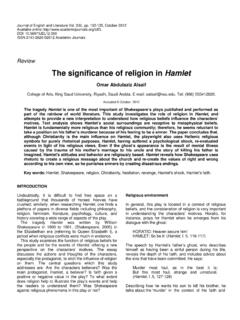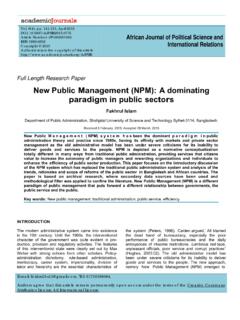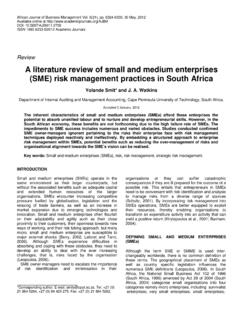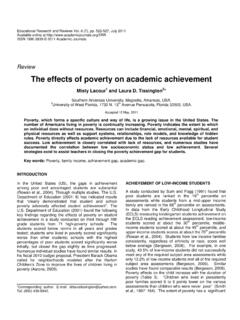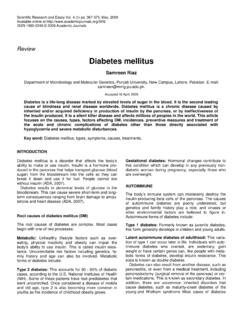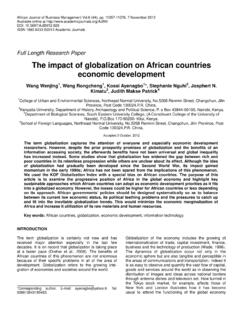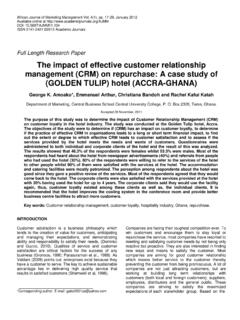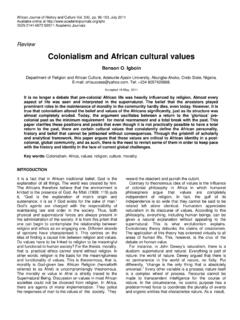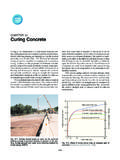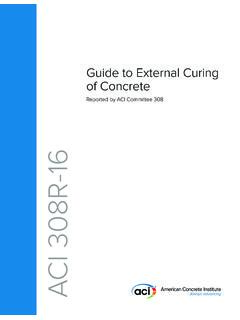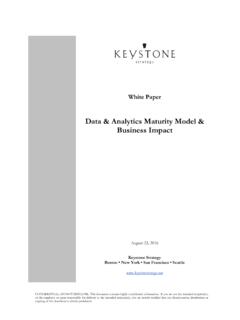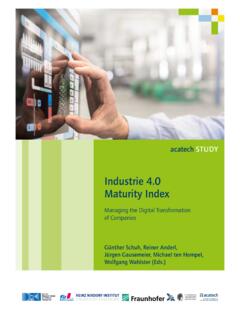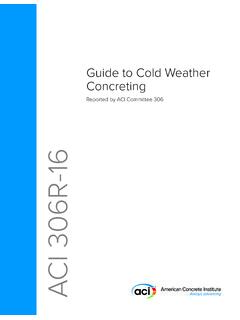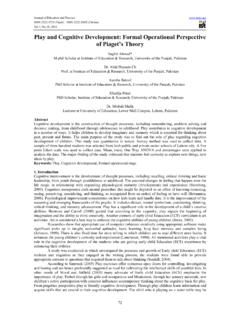Transcription of Piaget’s theory of intellectual development and its ...
1 Educational Research and Reviews Vol. 5(7), pp. 366-371, July 2010 Available online at ISSN 1990-3839 2010 Academic Journals Full Length Research Paper Piaget s theory of intellectual development and its implication for instructional management at pre- secondary school level Enose M. W. Simatwa Department of Educational Management and Foundations, Maseno University, MASENO, Kenya. E-mail: Tel: 254735261121. Accepted 13 May, 2010 Instructional management focuses on planning, execution and evaluation of learning experiences. For teachers in pre-secondary schools to plan, execute and evaluate learning experiences effectively, they need to have good understanding of the process of cognitive development in children. Piaget has postulated that children progress through a series of four stages beginning with rudimentary reflex responses and achieving full maturity with the attainment of formal deductive reasoning.
2 Piaget s theory also postulates that a child is an active investigator who acts upon his environment with reflex responses during infancy and then with more complex responses that emerge from early interactions. Piaget views interaction as a two-way process, one of which is accommodation and the other is assimilation. In accommodation the child s knowledge of the environment is modified to incorporate new experiences which are adaptive to the broad aspect of cognitive demands imposed by the environment. In assimilation, the child incorporates new experiences into an existing structure. Accommodation and assimilation are reciprocal and their interaction generates cognitive growth. Understanding and application of Piaget s theory is important in the effective enhancement of teaching and learning process at pre-secondary school level.
3 Consequently, teacher trainers, trainee teachers and practicing teachers need to keep abreast of Piaget s theory of intellectual development . Key words: intellectual development , Instructional management and Pre-secondary schools. INTRODUCTION Jean Piaget s theory of intellectual development (Flavell, 1963) is considered a leading theory on cognitive development (Flavell, 1963). Piaget s theory asserts that intellectual development is a direct continuation of inborn biological development . That is the child is born biolo-gically equipped to make a variety of motor responses, which provide them with the framework for the thought processes that follow. That is, the ability to think springs from the physiological base.
4 Piaget maintains that intelligence is rooted in two biological attributes found in all living creature: organization and adaptation. Organi-zation is the tendency of every living organism to integrate processes into coherent systems. It occurs, for instance, when an infant, originally capable of either look-ing at objects or grasping them, integrates these two separate processes into a higher order structures which enable him to grasp something at the same time he looks at it. Adaptation is the innate tendency of a child to interact with his environment. This interaction fosters the development of a progressively complex mental organization. Each stage in this sequence of development provides the foundation for the next stage permitting progressively complex and effective adaptations to the environment.
5 Adaptation comprises two complementary processes of assimilation and accommodation. The child assimilates experiences and fits them into the expanding structure of the intellect when he encounters new experiences which he cannot fit into the existing structure accommodation, or modified way of reacting takes place. Piaget stresses that as children mature mentally, they pass sequentially through four major stages of cognitive development , each stage having several sub stages (Hertherington and Park, 1975). The major stages of cognitive growth are: 1. Sensory motor stage - 0 - 2 years 2. Preoperational or intuitive stage - 2 - 7 years 3. concrete operations stage - 7 - 11 years 4. Formal operations sage - 11 - 15 years These stages are of a probabilistic nature.
6 At most ages it is possible for a child to exhibit behavior characteristic of more than a single stage because heredity interacts with environment. Each stage is a system of thinking that is quantitatively different from the preceding stage. Each stage is a major transformation in thought processes compared to the preceding stage. The stages are sequential and follow an invariant sequence. This means that the child cannot skip or miss a stage or by - pass a stage. He must go through each stage in a regular sequence. Children cannot overcome a developmental lag or speed up their movement from one stage to the next. They need to have sufficient experience in each stage and sufficient time to internalize that experience before they can move on.
7 MENTAL development OF CHILDREN AT VARIOUS STAGES AND THEIR IMPLICATIONS FOR INSTRUCTIONAL MANAGEMENT Pre-school (sensory motor) 0-2 years During this stage, cognitive activity is based on immediate experience through the senses (Meyer and Dusek, 1979). The major intellectual activity here is the interaction of the senses and the environment. Children have not developed a language for labeling experiences or symbolizing and hence remembering events and ideas. They therefore see what is happening and feel it, but they have no way of categorizing their experiences. Responses are almost completely determined by the situation. For example, a hungry child will literally scream the house down for food.
8 It does no good to tell a six month old, now just a moment , I am warming your milk. The child has no way to represent the idea that in one or two minutes, nice warm milk will appear in a bottle. He obviously does not know what a minute is or what any of those other words mean. During this stage a phenomenon known as visual pursuit is manifested. The child will visually pursue an object relentlessly, long after an older child would have lost interest. Such visual pursuit develops the capacity of object permanence , a primitive form of memory (Meyer and Dusek, 1979). As children begin to develop intellectually, they understand that when an object disappears from view, it still exists even though they Simatwa 367 cannot see it.
9 This implies that day-care centers should operate quality programmes that guarantee a rich and responsive sensory environment. This in effect should be directed to nurturing the innate faculty of intellectual development . It also means that daycare center managers should be knowledgeable in balanced nutrition matters. Nursery school (pre-operational or intuitive): 2-7 years During this stage intuitive mode of thought prevails characterized by free association, fantasy and unique illogical meaning. The child can symbolize experience mentally. This is facilitated by the development of language skills (Meyer and Dusek, 1979). He uses egocentric speech. Children often talk at, rather than to each other in what Piaget calls collective monologues.
10 The child learns to associate words and symbols with objects. He develops an awareness of the conservation of mass, weight and volume. Since the nursery school child has to solve new problems on the basis of a limited past experience, he is likely to encounter contradictions as a result of faulty generalizing (Meyer and Dusek, 1979). When faced with such contradictions, a child at a lower level of development usually shrinks from them but a child at a higher level may become disturbed. This is illustrated by the experiments in which children watch someone pouring colored water back and forth between a 200 ml beaker and a 500 ml beaker. A four year-old may be totally unconcerned about the fact that the water level differs in the two containers.
